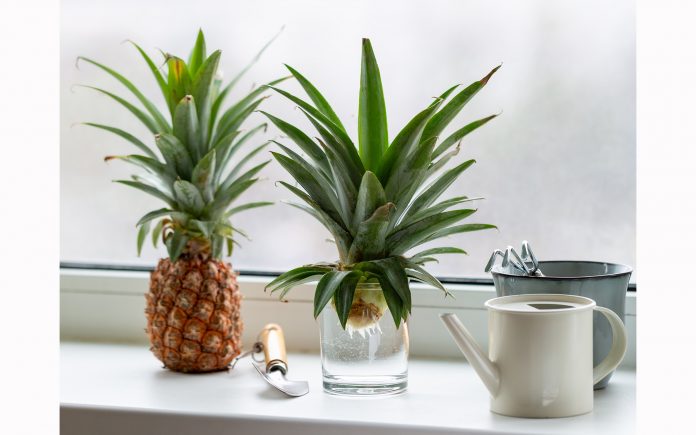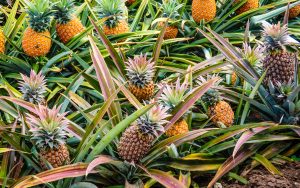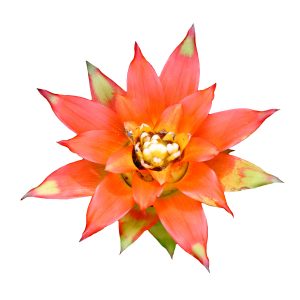
This is a great project to start as we all wait in our homes for life to resume! However, this growing experience can take years, yes YEARS – and we all hope we won’t be at home that long! You can use a windowsill or any bright sunny spot for this tropical plant – A PINEAPPLE!
 What type of plant is a pineapple? Pineapples are classified as Bromeliads. Pineapples scientific name is Ananas comosus. The first pineapples were found growing in Brazil. Despite our thoughts that Hawaii grows our pineapples, they actually follow this order in production: #1. Costa Rica, #2. Brazil, #3. Philippines, #4. India. (Very Interesting fact, I would not have come close to answering that correctly!)
What type of plant is a pineapple? Pineapples are classified as Bromeliads. Pineapples scientific name is Ananas comosus. The first pineapples were found growing in Brazil. Despite our thoughts that Hawaii grows our pineapples, they actually follow this order in production: #1. Costa Rica, #2. Brazil, #3. Philippines, #4. India. (Very Interesting fact, I would not have come close to answering that correctly!)
If you want to grow your own pineapple, follow the steps listed below. You need to be patient, it can take 3 to 4 years, you will have your own homegrown pineapple. (if all goes well)
To grow your own pineapple, you need to start with one you purchase. Be careful when you choose the ONE. This will determine your success. Most local grocery stores stock fresh pineapples. It is important that you choose the perfect pineapple. Not overly ripe. Yet an immature pineapple can’t produce an offspring. The pineapple needs to be fresh, yet mature.
Pick out your pineapple and inspect it for the following:
Color: Brown, but not too dark or too light. If it is yellow, it is not ripe.
Firm: Not overripe or under-ripe, if it feels hard it is not ready.
Leaves: They should be green, and not bent or broken
Smell: The pineapple should have a sweet smell
All the above will guarantee that you have the perfect pineapple for reproduction of a new baby pineapple.
When you get ready to eat the purchased pineapple, slice off the top with a small section still attached to the leaves. Allow the pineapple to dry at the base. I usually wait several days before I place the base in water.
Before you place the bottom area in water, cut off the pineapple fruit around the base. Make sure you do not cut off where the leaves join the base. The fruit itself will rot if placed in water. Sometimes you can’t remove all the flesh from the plant. The flesh will rot. Remove as it rots. If you leave the flesh part, you will probably not have success.
I try to change the water every few days to keep the water fresh. The fleshy part will fall off at some point. This will leave the core. The leaves will remain attached to the core and the roots will extend into the water at the base or core region.
It can take about 6 weeks for the roots to develop. I change the water every other day or as needed. Make sure that the core is covered in water, however you do not want the leaves in the water.
 Once the roots begin to develop you can plant the pineapple in a container. I like to use a large container so that I do not have to repot as it grows. The leaves should not be covered with soil. If the pineapple is not sturdy in the container, try adding a bamboo stick on each side for support. ( metal rods work also). It will take several years (about 3 yrs.) before the plant will be ready to produce a pineapple. Patience is important. Remember Rome was not built in a day.
Once the roots begin to develop you can plant the pineapple in a container. I like to use a large container so that I do not have to repot as it grows. The leaves should not be covered with soil. If the pineapple is not sturdy in the container, try adding a bamboo stick on each side for support. ( metal rods work also). It will take several years (about 3 yrs.) before the plant will be ready to produce a pineapple. Patience is important. Remember Rome was not built in a day.
After about three years your plant is ready to produce a pineapple, you can nudge it along. If you take a plastic bag and a large apple cut in half. You will only use one half of the apple. Lay the apple inside the pineapple top. Cover the plant with a plastic bag. Tie the bag so that the ethylene gas is trapped in the bag. Leave the bag on for 4 to 6 days. This will provide the environment needed for a new pineapple to form. The apple gives off the gas that triggers the plant to reproduce.
 Remove the bag and apple. Continue to add water to the leaf cups. This process can take up to 14 or more weeks before the new pineapple will begin to form. Before the pineapple forms you will be rewarded with a beautiful red flower. This red flower will become the pineapple. During this time, keep the plant in a sunny location and wait. Success will come if conditions are right.
Remove the bag and apple. Continue to add water to the leaf cups. This process can take up to 14 or more weeks before the new pineapple will begin to form. Before the pineapple forms you will be rewarded with a beautiful red flower. This red flower will become the pineapple. During this time, keep the plant in a sunny location and wait. Success will come if conditions are right.
The three-year process should give you a greater appreciation of a pineapple even if you decide to not grow your own!
– Jane Slone writes articles on gardening for EllisDownHome.com. Jane grew up in Dallas, and moved with her husband to Ellis County 25 years ago. She opened three flower shops, operated, and eventually sold the shops. She taught Microbiology and Anatomy & Physiology at the college level and retired 26 years later. She loves to garden and has become a Master Gardener. Her joy is teaching others about gardening!






